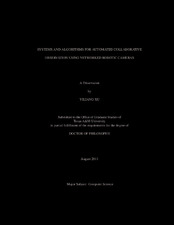| dc.description.abstract | The development of telerobotic systems has evolved from Single Operator Single Robot (SOSR) systems to Multiple Operator Multiple Robot (MOMR) systems. The relationship between human operators and robots follows the master-slave control architecture and the requests for controlling robot actuation are completely generated by human operators. Recently, the fast evolving advances in network and computer technologies and decreasing size and cost of sensors and robots enable us to further extend the MOMR system architecture to incorporate heterogeneous components such as humans, robots, sensors, and automated agents. The requests for controlling robot actuation are generated by all the participants. We term it as the MOMR++ system. However, to reach the best potential and performance of the system, there are many technical challenges needing to be addressed. In this dissertation, we address two major challenges in the MOMR++ system development. We first address the robot coordination and planning issue in the application of an autonomous crowd surveillance system. The system consists of multiple robotic pan-tilt-zoom (PTZ) cameras assisted with a fixed wide-angle camera. The wide-angle camera provides an overview of the scene and detects moving objects, which are required for close-up views using the PTZ cameras. When applied to the pedestrian surveillance application and compared to a previous work, the system achieves increasing number of observed objects by over 210% in heavy traffic scenarios. The key issue here is given the limited number (e.g., p (p > 0)) of PTZ cameras and many more (e.g., n (n >> p)) observation requests, how to coordinate the cameras to best satisfy all the requests. We formulate this problem as a new camera resource allocation problem. Given p cameras, n observation requests, and [epsilon] being approximation bound, we develop an approximation algorithm running in O(n/[epsilon]³ + p²/[epsilon]⁶) time, and an exact algorithm, when p = 2, running in O(n³) time. We then address the automatic object content analysis and recognition issue in the application of an autonomous rare bird species detection system. We set up the system in the forest near Brinkley, Arkansas. The camera monitors the sky, detects motions, and preserves video data for only those targeted bird species. During the one-year search, the system reduces the raw video data of 29.41TB to only 146.7MB (reduction rate 99.9995%). The key issue here is to automatically recognize the flying bird species. We verify the bird body axis dynamic information by an extended Kalman filter (EKF) and compare the bird dynamic state with the prior knowledge of the targeted bird species. We quantify the uncertainty in recognition due to the measurement uncertainty and develop a novel Probable Observation Data Set (PODS)-based EKF method. In experiments with real video data, the algorithm achieves 95% area under the receiver operating characteristic (ROC) curve. Through the exploration of the two MOMR++ systems, we conclude that the new MOMR++ system architecture enables much wider range of participants, enhances the collaboration and interaction between participants so that information can be exchanged in between, suppresses the chance of any individual bias or mistakes in the observation process, and further frees humans from the control/observation process by providing automatic control/observation. The new MOMR++ system architecture is a promising direction for future telerobtics advances. | en |


